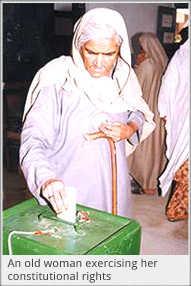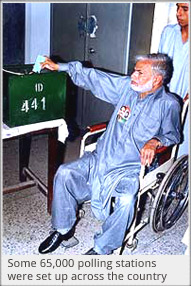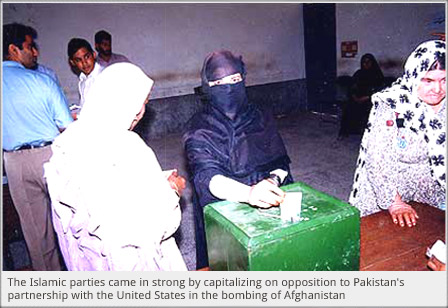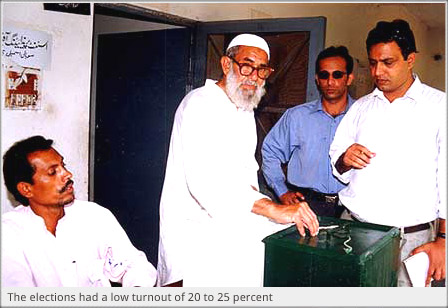After three years of military rule, Pakistan again headed towards democracy on October 10, 2002. More than 70 parties, big and small, contested the eighth national parliamentary election. The major parties contesting the elections were Peoples Party Parliamentarians, Pakistan Muslim League-Nawaz Group, Pakistan Muslim League-Quaid-i-Azam also called the “King’s Party” for its unconditional support to the government, and the Muttahida Majlis-i-Amal (MMA), alliance of six religious political parties. Other known parties contesting at the national level included the six-party National Alliance led by former caretaker Prime Minister Ghulam Mustafa Jatoi, Imran Khan’s Pakistan Tehrik-i-Insaaf and Tahir-ul-Qadri’s Pakistan Awami Tehrik. Several regional parties, with strongholds in their own provinces included the Sindh-based Muttahida Qaumi Movement, Awami National Party, Jamhuri Watan Party, factions of Baluchistan National Movement and Pashtunkhwa Milli Awami Party.
The National and Provincial elections were held on the same day. More than 72 million registered voters aged 18 and above from a population of 140 million, elected members for the 342 National Assembly seats and 728 seats of the four Provincial Assemblies. A total of 2,098 candidates contested for 272 general seats of the National Assembly. The remaining 60 seats were reserved for women and 10 for non-Muslim minorities. These seats were to be allocated on the basis of proportional representation to parties bagging at least five per cent of the total general seats. In the Provincial Assemblies out of the full 371 seat Punjab Assembly, 66 were reserved for women and eight for minorities, in the 168 seat Sindh Assembly, 29 for women and nine for minorities, in the 124 seat N. W. F. P. Assembly, 22 for women and three for minorities, and the 65 seat Baluchistan Assembly, 11 for women and three for minorities.
Voting was carried out from 8 in the morning till 5 in the evening on some 65,000 polling stations having 164,718 polling booths across the country, with segregated voting booths for women. The elections were observed and monitored by hundreds of local and 300 international observers, including observers from European Union and the Commonwealth, as well as local rights group.
 These elections were different from the previous ones due to the number of legislation passed by the Government. Convicted people were barred from taking part in elections under the Representation of the People’s Act. Several other politicians were unable to contest the elections, as they did not have a Bachelor’s Degree, which was a mandatory qualification in the elections. Pakistan’s leading political personalities Benazir Bhutto of the P. P. P. and Nawaz Sharif of the Pakistan Muslim League-Nawaz Group were barred from standing in the elections under the new electoral laws. And for the first time since 1977, the minority communities that included Christians, Hindus and Parsees contested and voted for all general seats in the National and Provincial Assemblies. The age limit of voting in these elections was also lowered from 21 to 18 years.
These elections were different from the previous ones due to the number of legislation passed by the Government. Convicted people were barred from taking part in elections under the Representation of the People’s Act. Several other politicians were unable to contest the elections, as they did not have a Bachelor’s Degree, which was a mandatory qualification in the elections. Pakistan’s leading political personalities Benazir Bhutto of the P. P. P. and Nawaz Sharif of the Pakistan Muslim League-Nawaz Group were barred from standing in the elections under the new electoral laws. And for the first time since 1977, the minority communities that included Christians, Hindus and Parsees contested and voted for all general seats in the National and Provincial Assemblies. The age limit of voting in these elections was also lowered from 21 to 18 years.

The election results issued after inexplicable delay not only led to no major party having an overall majority in the new National Assembly, but also were surprising with an unexpectedly large number of seats won by the Islamic parties. The religious alliance known as Muttahida Majlis-i-Amal (MMA) secured 51 seats, emerging as the third largest party in the National Assembly elections after P. M. L. (Q) with 76 seats and PPPP with 62 seats. A total of 121 seats were won by three major anti-Government parties, including 62 seats by PPPP, 51 by MMA and the PML (N) won 14 seats. The Islamic parties, which previously had actually won fewer seats, came in strong this time by capitalizing on opposition to Pakistan’s partnership with the United States in the bombing of Afghanistan and in the war against terrorism. The MMA got a clear-cut majority in NWFP and Baluchistan provinces where it easily formed a government on its own. In the rest of the Provincial Assemblies coalition governments were formed as no party had come in with a complete majority.

The elections had a low turnout of 20 to 25 percent as compared to 35.42 percent in 1997 general election. Despite government assurances that the elections would be fair, free and transparent, different political parties alleged that the elections were engineered and the government was involved in massive rigging. It was alleged that ballot engineering was behind the sluggish pace of announcements of the election results.
With no party emerging with a simple majority Pakistan faced menace of a hung parliament. A coalition government was, however, set up with Mir Zafarullah Khan Jamali, the candidate of PML (Q) as the Prime Minister of Pakistan with the help of MQM, a number of independent candidates and 10 members of the Pakistan Peoples Party Parliamentarians who defected from the party to form their own Forward Block.

This article was last updated on Saturday, February 21, 2004






